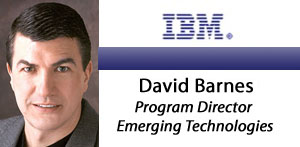IDN Expert Voices: Era of Enterprise Mobile
Mobile adoption by enterprise users is about to explode, with studies predicting growth at 40 percent per year through 2015. IDN ‘Expert Voices’ speaks with David Barnes, a program director at IBM’s Emerging Technologies unit, to find out how today’s IT architects can become their company's ‘go-to Mobile IT expert’ thanks in large part to their experience with SOA and browser-based applications.

|
 |
|||
Record Demand for Enterprise Mobile Will Be Met by Today’s SOA-Savvy Architects
Transcript below>
Mobile adoption by enterprise users is about to explode, with studies predicting growth at 40 percent per year through 2015. IDN ‘Expert Voices’ speaks with David Barnes, a program director at IBM’s Emerging Technologies unit, to find out how today’s IT architects can become their company's ‘go-to Mobile IT expert’ thanks in large part to their experience with SOA and browser-based applications.
Interview time: Approx 13 minutes
Interview Transcript
| Vance: | And this is Vance McCarthy, Program Director for Integration Developer News again with another in our series of Expert Voices talking about Trends and Business Critical Enterprise Architecture. And today I’m very pleased to be joined by David Barnes, Program Director at Emerging Technologies for IBM with today’s special focus on Mobile Business. David thanks for taking the time. | |
| David: | Thanks Vance, it’s great to be here. | |
| Vance: | You know David as I mentioned, I’m really looking forward to this conversation because I know you’re going to help me and our IT architecture audience answer some important questions that seem to be popping up quite frequently now about the raging phenomenon in mobile. Not many people think of IBM as mobile provider but they certainly think of you as a trusted enterprise IT architecture provider. Give us a sense of where IBM is seeing mobile on the IT and infrastructure radar, right now. | |
| David: |
Well I have to agree with you, a lot of people don’t think of us when they think about mobile but a lot of people don’t think about the underlying infrastructure that mobile requires. You know, everybody’s interested in the nice bright shiny phones but those phones are only an outlet for what typical IT architect might provide so we’re in about 170 of the top 198 service providers spaces. We touch about a billion mobile subscribers everyday with our software. The trends that we’re seeing are the enterprises now have realized they have to reach out to mobile devices. Mobile growth can’t be ignored anymore.
We can’t wait for it to happen. It’s happened with iPhones and iPads and Android and Blackberry, etc. So the time is now and most of our customers or a lot of customers are reaching out saying how do we get started and so the questions on everybody’s mind right now. |
|
| Vance: | Well let’s talk about that. What does IBM see that from infrastructure or the device side that would help the IT community cope with that? | |
| David: | Yeah, that’s a really good question because a lot of customers are asking, "How do we get started?" And then the second question they always have is, "What devices do we support?" or what devices they should support. We can no longer assume that a company is going to mandate what devices we carry or that they’re going to issue devices because we’re all carrying Smart Phones these days so being agnostic for example, supporting browser based applications is really important and from an IT architect’s perspective, think of that, browser based. Well, what if they all ready do, they supported the browser based application. Now it’s just to a different form factor. | |
| Vance: | You know and speaking that form factor; you kind of putting a seed in my mind that mobile may not be that difficult if I have a SOA or at least a browser base, REST base way of thinking. Is that what you’re telling me? | |
| David: | Yeah, our most successful rollouts with customers thus far, the customers attributed, hey we did this quickly because we had a SOA in place. You know we’ve talked about SOA and web services, etcetera for a long time and we said oh, it’s going to provide you this flexibility as things changed. Well guess what we were all right and everybody that invested in that was right and now the change is occurring and because they implemented on a SOA, hey we just extend the service out to a new device. It’s exactly what we’ve all been thinking all along | |
| Vance: | Speaking of the new device, I happen to see some of the notes here for preparation for this call. But IBM is actually some of the inside smarts for just about every Smart Phone you can think of. | |
| David: | Yeah, that’s an interesting one that I’ll tell you, when I first got involved in the mobile technologies in IBM, I was actually surprised about 80 percent of the worlds Smart Phones have software generated by our IBM development products. Now what does that mean, it means that the same things that people use today with perhaps a clips phase development tools, rationale tools, etcetera are the same ones that are being used to develop Smart Phones. You know Nokia puts out one model of phone and they may have to support 21 different versions of that model for all of the different areas and geography’s that they go out to. So they need the same versioning tools and the same development tools that enterprise architects are already familiar with which is pretty cool because it’s like oh, we already know that stuff. | |
| Vance: | The premise that IBM is the player in infrastructure, that it’s got application and support software elements in the actual phone device and that it knows some patterns about working with browsers all strike me as a good recipe for getting started and supporting mobile without having to totally re-jigger your IT staff assignments. | |
| David: | And that is absolutely correct. I’ll tell you, we had an engagement with Air Canada and what they wanted to do is what a lot of company’s want to do right now, they wanted to dip their toe in the water and they wanted to find out how do we fit in the mobile space. We worked with them on a SOA based architecture with our WebSphere App Server and DB2 and MQ series, all the things that most IT architects are already familiar with and we extended that. Now we helped them build out an application and now they’re on the iPhone and the Blackberry, etcetera. But the majority what they did there was already known by their IT architects. They just sort of extended it out to this new platform. | |
| Vance: | So all the issues with bidirectional communication and SLA and all these things, even if they’re not on a wire only but through the airwaves, is there any distinction for the IT community between supporting a browser based application and supporting the wireless version? | |
| David: |
I think one of the biggest concerns that a lot people are going to have here is around security. In fact, I will say that that’s probably the biggest concern because if you look at the backbone of the architecture, you know I mentioned WebSphere App Server, SOA Services, etcetera you get the same enterprise notification services that you have already for SMF and VoiP and all of the other things that are on your backbone just now out to a new device. "What do I do with the secure information out there?" "What do I do with the confidential information now our employees are carrying these devices?"
That’s one of the main concerns that people are expressing to us. And you know we’ve got IBM Mobile Enterprise Services, it’s a group within IBM that’s exactly what they work on. They make sure that they’ve got tracking and monitoring of the real time devices. Statistics they know where the devices are and you can wipe and kill the devices and that’s really important. |
|
| Vance: | I wonder is the security piece that you are talking about in this an extension of WebSphere or is it just another node that’s in this architecture? | |
| David: | It is extending WebSphere but it is extending it out to a new platform so I would add that in an architecture chart. Right now we reach out to other devices so is that space between what our enterprise services are and the device now. And so we’ve got some Tivoli monitoring tools and some other tools that provide support for that but in the architectural view, it’s very similar to any other devices hanging off the end of that. | |
| Vance: | So the premise here is that folks that might use authentication services or use Tivoli or asset manager type of component tree in conjunction with WebSphere, they’re very close to having their learning curve behind them when it comes to mobile support. | |
| David: | Absolutely, talk about learning curve. You know I mentioned Air Canada built out this application, really successful by the way. They’ve stuck it out on the App Store, the thing became the number one travel category app within a couple weeks but because we learned along the way, we learned that hey, this is really extending traditional [SOA] services and we went and did a similar thing with ING Direct. Now we realize hey, it’s not that intimidating and it was just about a month and ING Direct was from concept to completion, to the devices and their mobile customers running on their SOA backbone. | |
| Vance: | You know we’re showing a screenshot of the actual ING application and this looks like a B to C or client applications, is that true? | |
| David: | Yeah, absolutely. Being a financial system that is all externally based, in other words, they don’t have brick-and-mortar. They were prepared to be able to service their customers externally. Well now they anticipate that within the next two years, 50 percent of their customers will be using mobile devices to access their services. Fifty percent in two years, that’s incredible. | |
| Vance: | You know speaking of growth, put in context for the IT architect community that’s viewing this, where they’re career opportunities are, I see you put together some numbers here that are pretty eye popping. | |
| David: |
Yeah you know I love IT architects by the way. I’m with IBM. When I saw where the growth is, it makes me smile for IBM but also for an architect. We looked out to 2015 and we looked at the grown and devices which will continue to grow, no doubt. Applications on the devices, that will continue to grow too, but if you look at the big growth, management and mobile infrastructure. And when I say mobile infrastructure, that’s the same as we’re already familiar with, not much different from what we’re already familiar with. Theirs, the numbers are like 41 percent compound growth for infrastructure and 37 percent for management. IT architects are the ones that have to do that. They’re not going to be a group of new mobile people that learn how to do infrastructure and management between now and 2015.
We’re going to rely on the existing IT architect to do that because they already know how to architect solutions. And this isn’t really that different than hey, we architected to the browser right, and now all of a sudden there’s a new let’s say, window into our services and it happens to be a phone. |
|
| Vance: | You know the picture I take away from this conversation David, is that once there continues to be a very critical platform along with Tivoli for management. But that IBM has a very clear idea of how to matriculate the core infrastructure that IT architects already know and love for their mission critical traditional internet SOA architectures. And that mobile will not be this huge cross the chasm challenge for them. | |
| David: |
No, it’s incremental. We look at it likes it’s totally different thing and it brings up a lot of fear in people’s hearts and minds when they think, oh now we have to go out to the mobile platform. But I’d welcome IT architects to look at this as an opportunity and say hey, I already know how to do a lot of this stuff, why don’t I work with somebody in my organization, find an app that we already have that would benefit from being mobile, dip our towel in the water, check it out, and the next thing you know, you can be the architect that’s a hero to your CEO or your CIO. So it’s a great time for opportunity for the IT architect and there’s nothing to be afraid of. That’s the really good news. |
|
| Vance: | And it does should that I could do this in a very impactful way for my company whether it’s for end user customers or for enterprise employees, in as little as a 30 year, 60-day window. | |
| David: |
Absolutely, I talk to an architect with a big insurance company and we were talking about what do they need in the field and we hooked up with an agent that was in the field carrying a mobile device and he was also carrying a clipboard. I said, whoa a clipboard. Today, 2010 seriously and so we realized what’s this person doing? Well they were thinking of carrying a lap top but they got that little fob sticking out the side and they were breaking them in the field, etc. So we said, whoa let’s look at something like the new iPad that’s out and all of the new tablets that are coming out. And we said let’s extend an app that he already is familiar with, the architect and put it out to that device.
And in a very short period of time, he’s running a prototype on top of an iPad and it wasn’t very hard. And right now that project is going forward and chances are he’ll become a hero and he took it upon himself to give it a try. I mean just think of a mobile solution happening without an IT architect and you’ll realize that’s impossible. |
|
| Vance: | David Barnes, Program Director to Emerging Technologies for IBM on Mobile Business. Thanks very much for the conversation and for giving us some very strong insights about how mobile is closer than we think and frankly, easier than we think. | |
| David: | Thanks Vance. |










